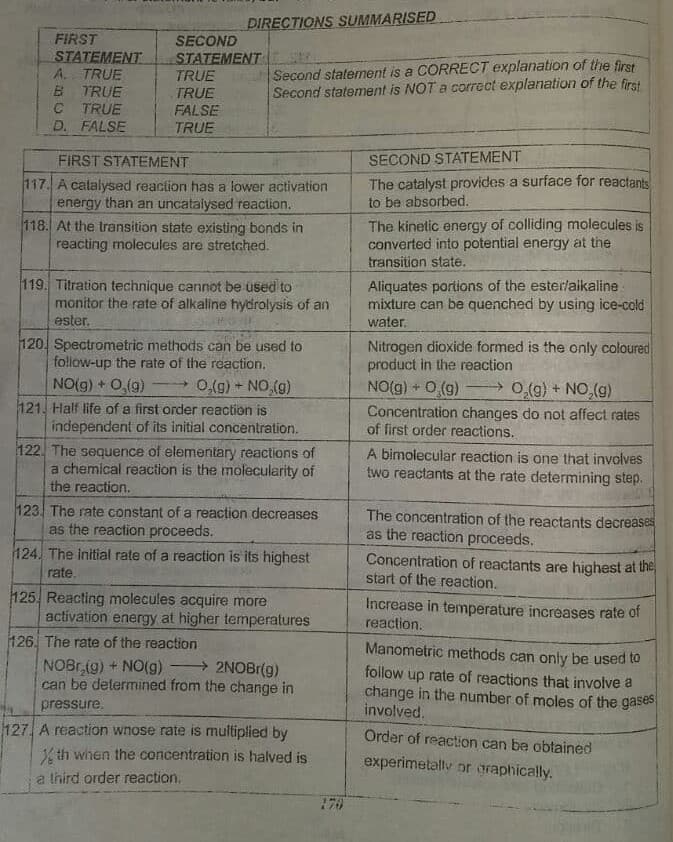DIRECTIONS SUMMARISED FIRST STATEMENT A. TRUE B TRUE C TRUE D. FALSE SECOND STATEMENT Second statement is a CORRECT explanation of the first Second statement is NOT a correct explanation of the firs TRUE TRUE FALSE TRUE FIRST STATEMENT SECOND STATEMENT The catalyst provides a surface for reactar to be absorbed. 117. A catalysed reaction has a lower activation energy than an uncatalysed reaction. 118. At the transition state existing bonds in reacting molecules are stretched. The kinetic energy of colliding molecules converted into potential energy at the transition state. 119. Titration technique cannot be used to monitor the rate of alkaline hydrolysis of an ester. Aliquates portions of the esterlaikaline mixture can be quenched by using ice-col water, 120. Spectrometric methods can be used to follow-up the rate of the reaction. Nitrogen dioxide formed is the only colour product in the reaction NO(g) + 0 (g) 0,(g) + NO,(g) NO(g) + O,(g) 0,(g) + NO,(g) - 121. Half life of a first order reaction is independent of its initial concentration. 122. The sequence of elementary reactions of a chemical reaction is the molecularity of the reaction. Concentration changes do not affect rates of first order reactions. A bimolecular reaction is one that involve two reactants at the rate determining step 123. The rate constant of a reaction decreases as the reaction proceeds. The concentration of the reactants decrea as the reaction proceeds. Concentration of reactants are highest at start of the reaction. 124. The initial rate of a reaction is its highest rate. 125, Reacting molecules acquire more activation energy at higher temperatures Increase in temperature increases rate o reaction. 126. The rate of the reaction Manometric methods can onty be used to follow up rate of reactions that involve a change in the number of moles of the ga involved. → 2NOBr(g) NOBr,(g) + NO(g) can be determined from the change in pressure. 127 A reaction wnose rate is multiplied by % th when the concentration is halved is Order of reaction can be obtained experimetally or graphically. a third order reaction.
Electronic Effects
The effect of electrons that are located in the chemical bonds within the atoms of the molecule is termed an electronic effect. The electronic effect is also explained as the effect through which the reactivity of the compound in one portion is controlled by the electron repulsion or attraction producing in another portion of the molecule.
Drawing Resonance Forms
In organic chemistry, resonance may be a mental exercise that illustrates the delocalization of electrons inside molecules within the valence bond theory of octet bonding. It entails creating several Lewis structures that, when combined, reflect the molecule's entire electronic structure. One Lewis diagram cannot explain the bonding (lone pair, double bond, octet) elaborately. A hybrid describes a combination of possible resonance structures that represents the entire delocalization of electrons within the molecule.
Using Molecular Structure To Predict Equilibrium
Equilibrium does not always imply an equal presence of reactants and products. This signifies that the reaction reaches a point when reactant and product quantities remain constant as the rate of forward and backward reaction is the same. Molecular structures of various compounds can help in predicting equilibrium.
Show all working explaining detailly your solution.
Answer Q 124 , 125 & 126

Step by step
Solved in 2 steps with 2 images









